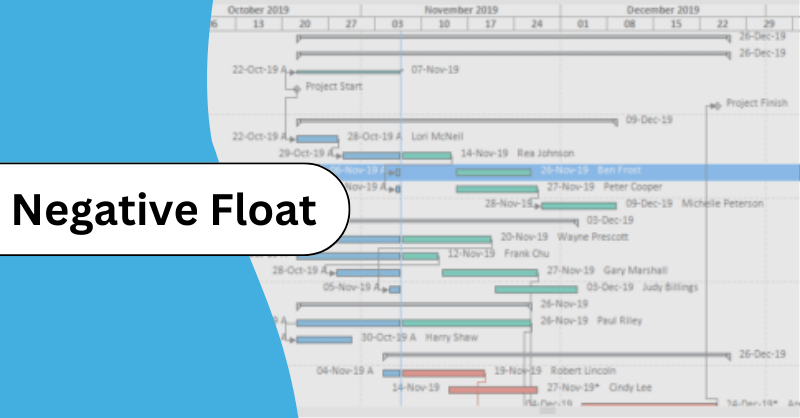What is negative float in project planning and scheduling? What are the different float types and how they can affect your project? How do you manage negative float in Primavera P6?
This article will try to answer these questions.
Introduction to Float
A planner will create a baseline program with proper links and a clear sequence. A good planner will understand and control the float resulting from this sequence in the program. Float can “make or break” the project control process, claims, and overall project success. This is why it is the most contested item in disputes and delay analysis.
Therefore, it is important to understand what is float, when it is negative and more importantly what to do when we have a negative float in a program.
Project Planning
The first step in planning is identifying the project scope and then breaking it down into packages and activities. Establishing the inter-dependence among the activities represents the work sequencing and the logical order of doing the work.
Activity sequencing is defined by the type of logic, wherein;
- Hard logic: Inherent in the work to be done and involves physical limitations
- Soft Logic: Depends on the activity types, resource contestants and is usually defined by the project team.
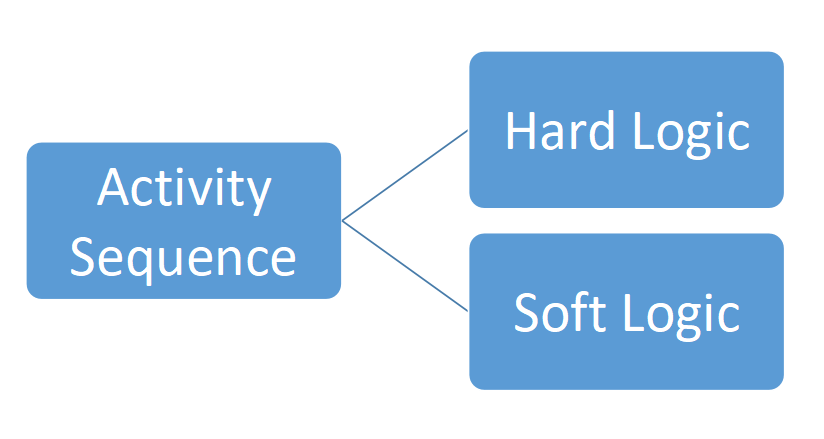
What is Float?
As a result of activity sequencing, each activity will have an early start date and a late start date, and a certain amount of time where it can be delayed or postponed without affecting the start or finish of succeeding activities.
To sump up,
- Earliest Start (ES) – earliest time an activity can start.
- Earliest Finish (EF) – earliest time an activity can finish. EF = ES + D
- Latest Finish (LF) – the latest time an activity can be finished.
- Latest Start (LS) – the latest time that an activity can be started without delaying the completion date of the project. LS = LF – D.
The Total float = LF – EF or the LS – ES.
Therefore, once you have a negative Total Float in a schedule, the early start dates of your activities are starting after the late start dates. This occurs when a predefined logic in a schedule is overruled or not being met. For example, if an activity with Finish Constraint is not finishing on the planned date (the constrained date) then it will show a negative float.
Whilst most people know there are two types of float, an experienced planner understands that there are Four (4) types of float:
- Total Float (TF): The total time that an activity can be delayed without causing any delay to the early start of the project’s critical path.
- Free Float (FF): The total time that an activity can be delayed without causing any delay to the early start of the following activities.
- Interfering Float (IF): The total time utilized in the current activity that interferes with its following activities
- Independent Float (Ind.F): The total time between an activity’s late finish and the early start of the following activities.
Below is a screenshot of a typical programme layout showing Total float and free float.

As show below, Primavera P6 the Total float is computed as follows.
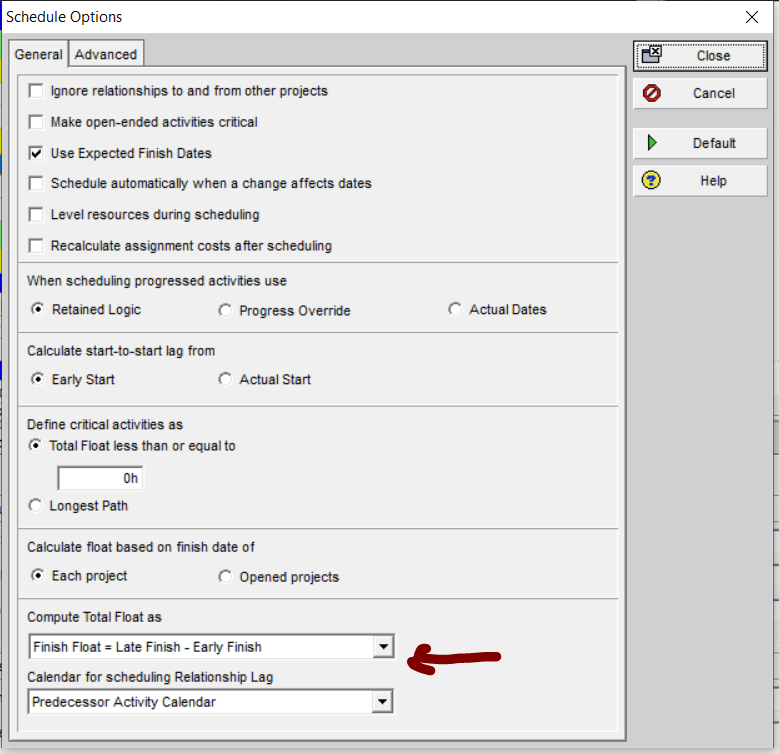
It is important to note that Primavera P6 can calculate the Total Float either by:
- Finish Float = Late Finish – Early Finish.
- Start Float = Late Finish – Early Finish.
- Smallest of Start Float and Finish Float.
Noting that out-of-sequence activities will have an impact on how Start/Finish dates are computed and hence will have an impact on the float calculations.
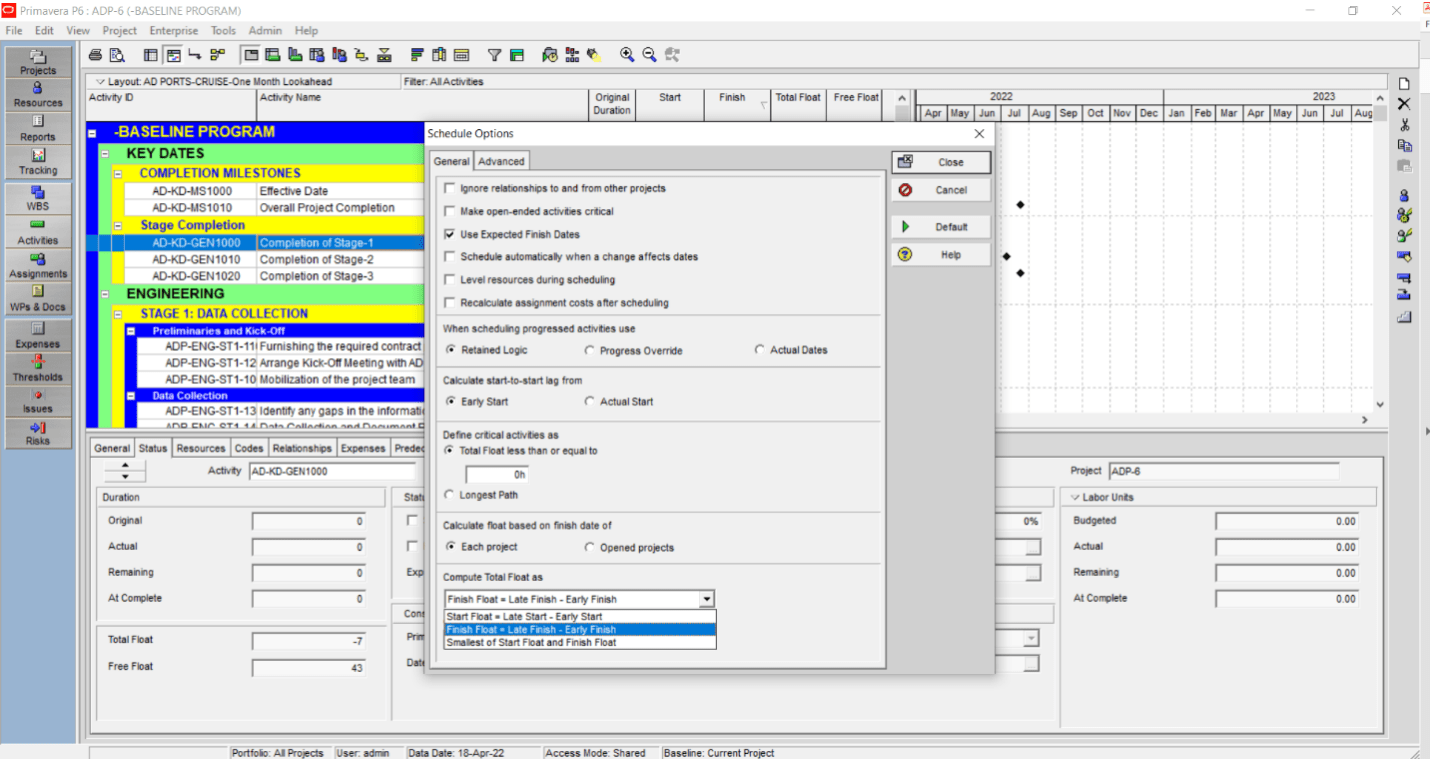
Negative Total Float
Negative float occurs in Primavera P6 when the total float is less than Zero, which means that the critical activities in the original plan (activity with zero total floats) are being delayed and the original project completion date is delayed.
See the below example, for the same activities but with a negative float.

There are many reasons why an activity could have a negative float:
- The activity start date is delayed due to a predecessor activity being delayed and affecting its start. The logic type is usually due to Finish-to-Start or Start-to-Start logic.
- The activity finish date is delayed due to a predecessor being delayed. The logic type, in this case, is usually Finish-to-Finish.
- There is a constraint condition on the activity that is not being met.
See the below example:
The below activity has a “Finish on” constraint on 17-May-22. The forecast completion date is 24-May-22, and hence the total negative float.
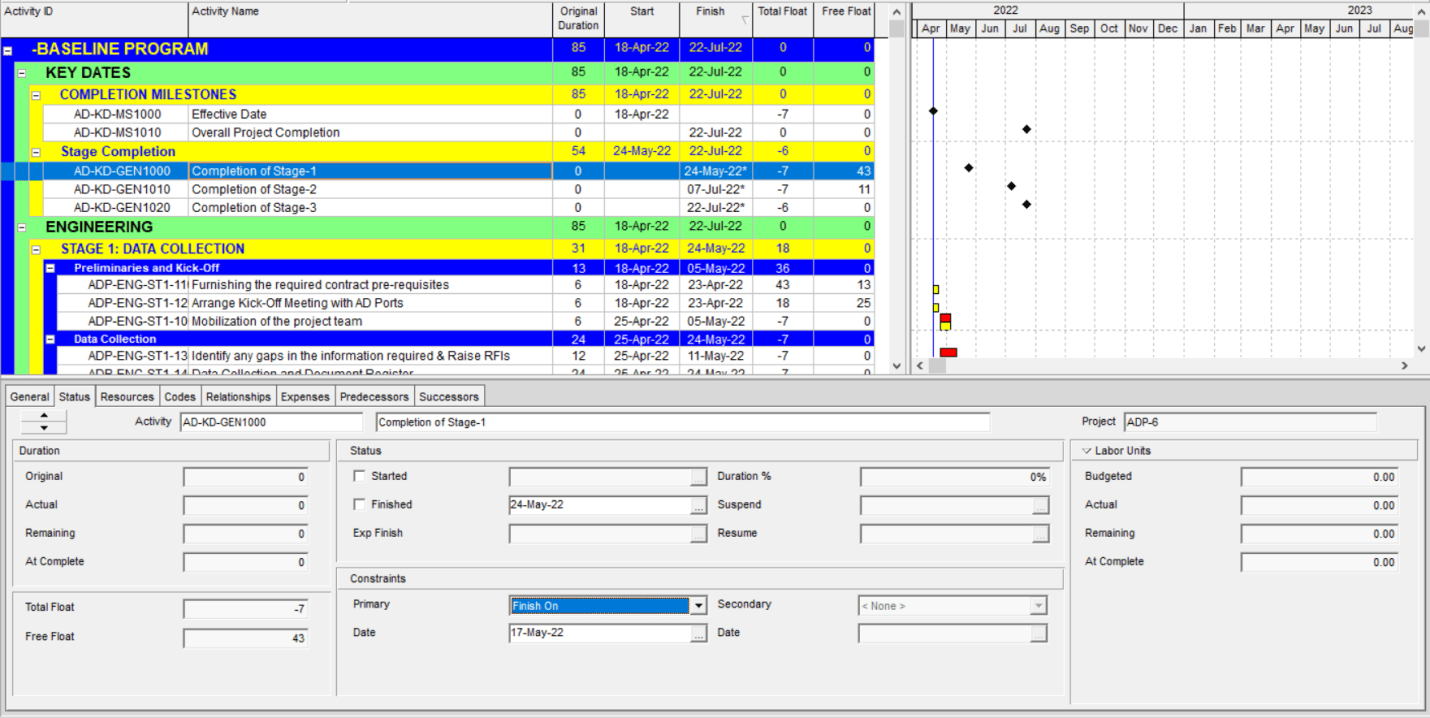
Below is an illustration of other possible type of activity constraints in Primavera P6.
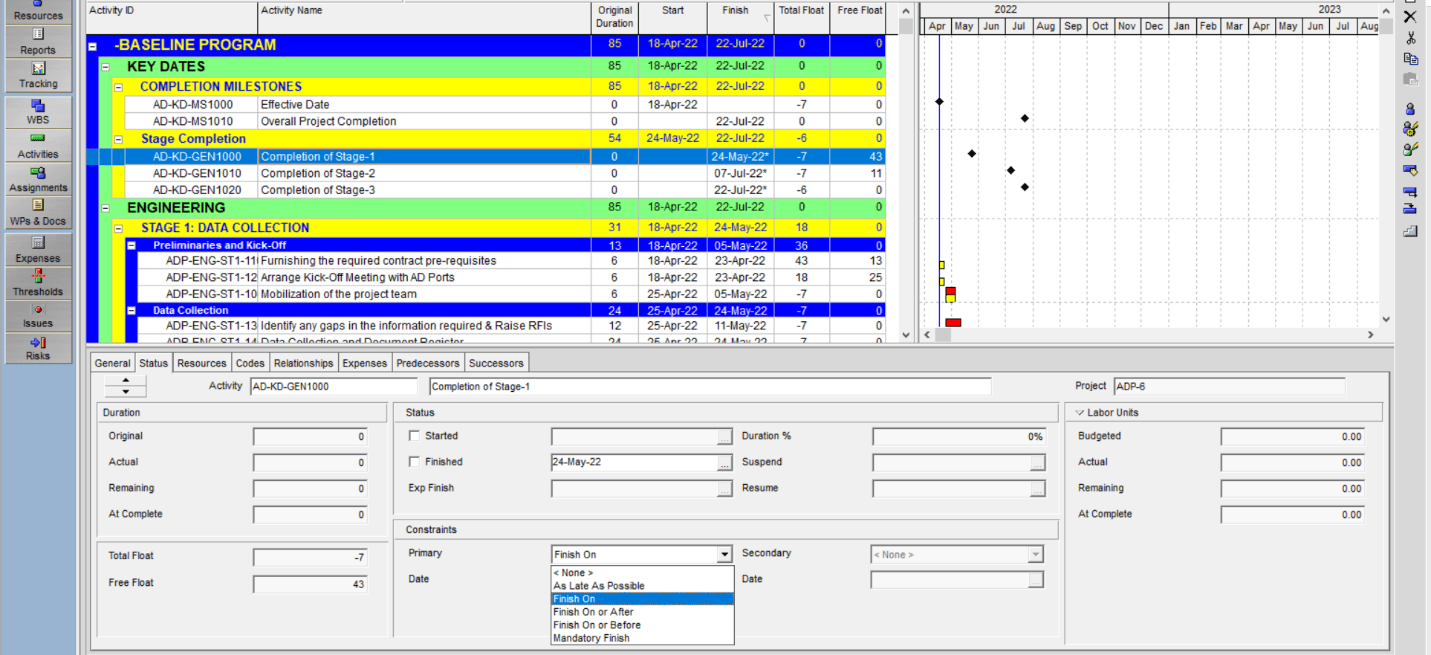
The real question is how to deal with negative total float?
Dealing with negative float is very important for the health of the project schedule. There are several ways to deal with negative total float, applying them depends on the cause of this float, and the planner’s view of the project.
Careful consideration must be given as explained below. The main causes of negative float are listed below:
- Delay in the project update due to project progress.
- A project constraint is not being met.
- Poor scheduling techniques.
Delay in the project update due to project progress.
Since a proper project schedule is based on, logic and interconnection between the activities. The slow progress in certain activities can result in the consumption of total flow available in the network. If the activity is on the critical path, it has zero total floats which means that any delay in the activity predecessor will result in a negative total float.
Even if the activity is not on the Critical Path, excessive delay in the activity progress or activity processor progress will result in the consumption of any positive total float, and eventually, the activity will become critical.
It is important to properly assess the situation when dealing with negative float.
In case the delay in project progress is attributed to external factors, then the cause of this negative float must be highlighted and reported to the project management team to take the necessary actions. These actions include issuing a notice of delay/ claims and informing the project delay owner about the delay cause and potential impact.
Discover the top 8 reasons for delays on construction projects
In this case, it is advisable to maintain the project records and update XERs showing the delays. These records shall be used later on to demonstrate the “cause and effect” of the delays attributed to external factors.
In case the delay is due to internal factors, then the delay cause must be reported to the project management team to take the necessary corrective actions and possible mitigation measures.
Possible corrective actions to be taken to reduce the negative float:
- Increase the progress by increasing the resources.
- Reduce the lag between activities, as possible.
- Change the relationship type between activities as possible. For example, changing Finish-to-start logic to Start-to-Start with reasonable lag (as reasonably possible).
- Change the status of constrained activities (as reasonably possible).
A project constraint is not being met
In the case of a constraint not being met, there are two solutions to fix this issue in Primavera P6:
Either by changing the Constraint date if it is not a contractual requirement, or:
By changing in the logic of the activities leading to the constrained activity.
Poor Scheduling Techniques
Poor scheduling techniques can result in negative floats. This can include:
- Excessive use of constraints.
- Poor planning of resource allocation and activity types.
- Update errors or incorrect project updates.
- Calendar errors and other general errors that can occur during the preparation of the schedule.
Example on how to remove a negative total float:
As shown below, the following schedule is showing a total negative float:

Upon review of the schedule, it is evident that the “Completion of Stage 3” activity has a “Finish On” constraint which is not being met, resulting in a negative float amongst the activity in the network.
By analyzing the schedule and reviewing the driving and critical activities, it is envisaged that the program critical activities are driven by the “Mobilization of the Project team” activity which has a 7 day lag.
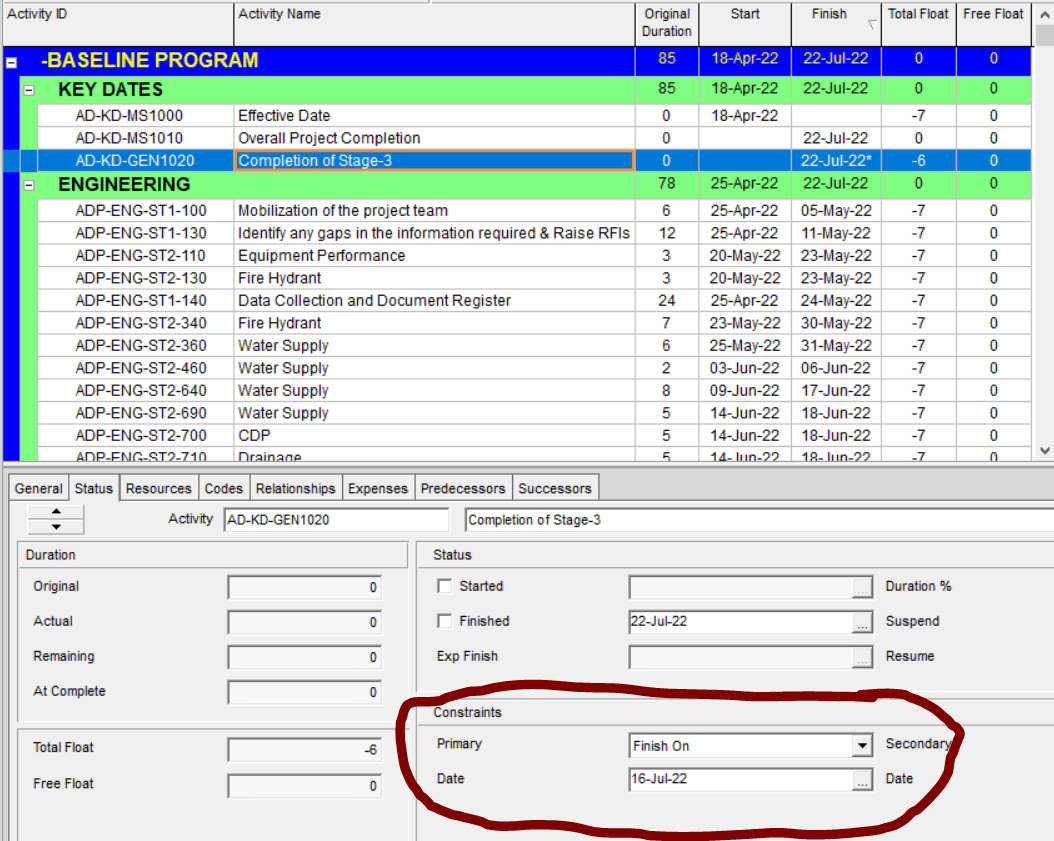
By discussion with the project team, it is evident that the “7 days” lag is unnecessary and can be reduced or removed. The corrective action is applied and the program is re-scheduled, and the negative lag is gone.
Managing float in a Project
The changes in a project activities total float from one update to the other must be carefully monitored and reviewed. Some activities might have an additional float which can be utilized by the project management team by focusing on other activities and hence, reducing the overall resources required for those activities.
Pertinently, drastic changes in the float might indicate problems in the project that must be raised to the management to determine the best course of action as stated earlier.
On the other hand, there are other specific situations such as “Project Pacing” that require utilization of the float and application of certain contractual procedures.
Total float is an important asset; one can consider it a gold mine, in a construction project. Most project management experts consider total float to be an asset belonging to the project and not exclusively to one party. A good planner will try to utilize the project float to protect the time and cost requirements of his/her team without compromising the project schedule health.

